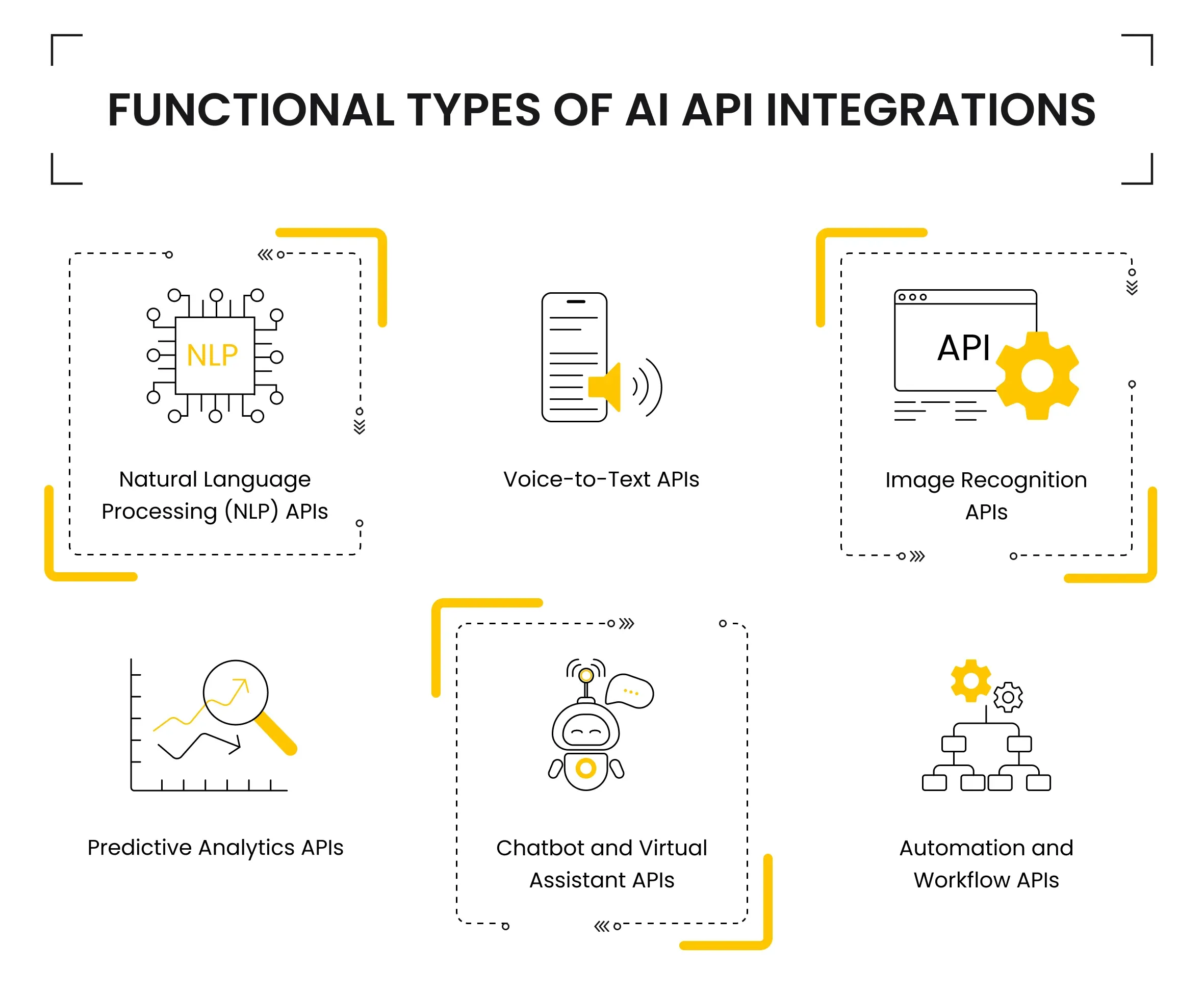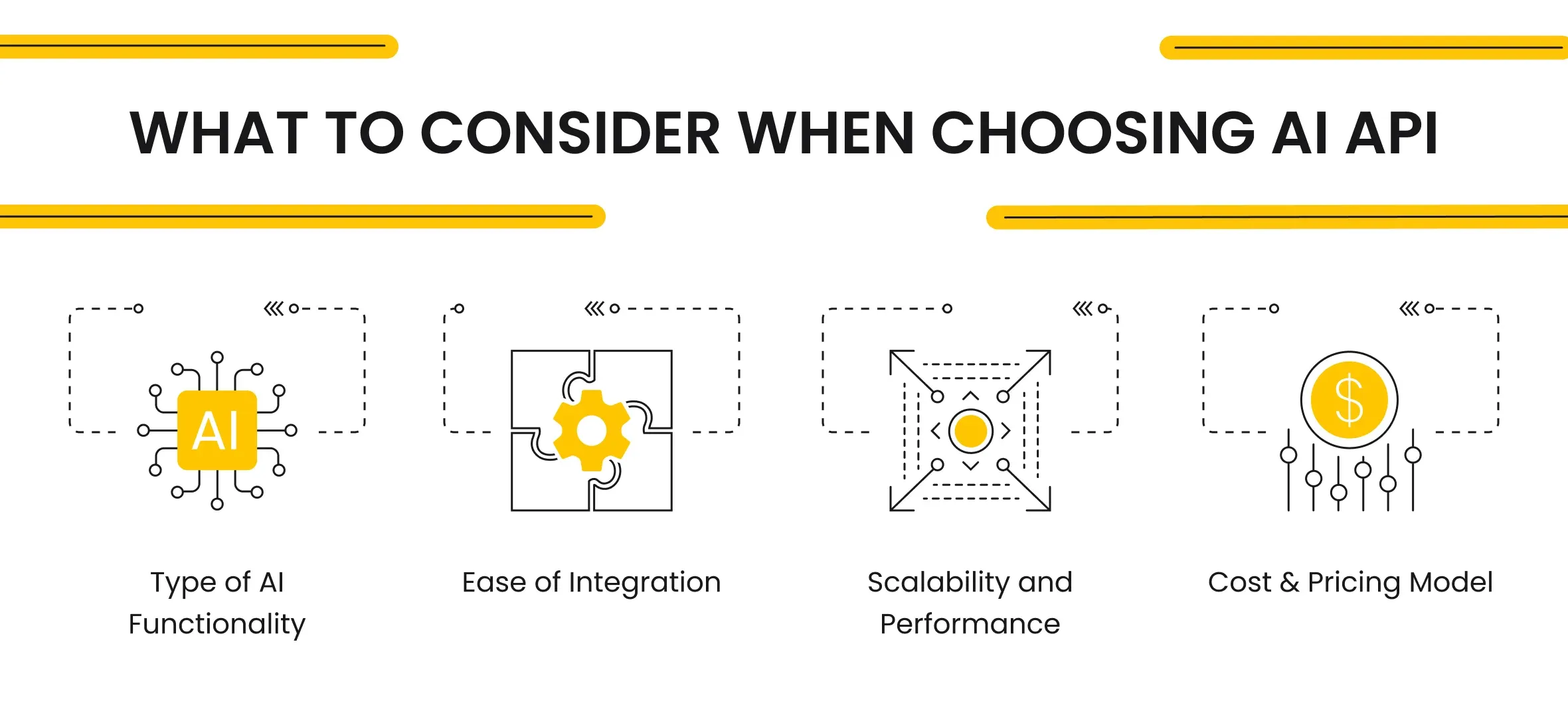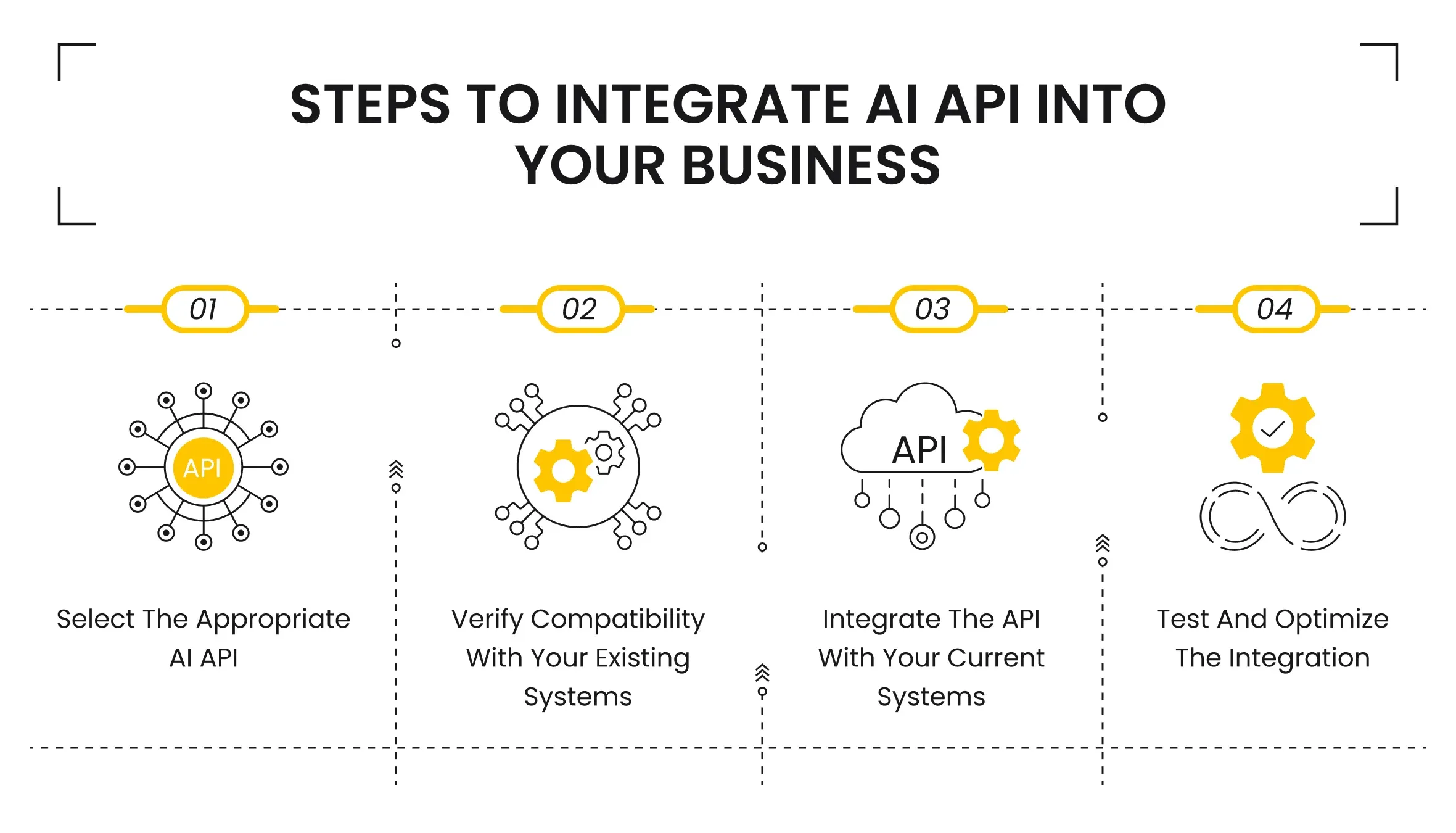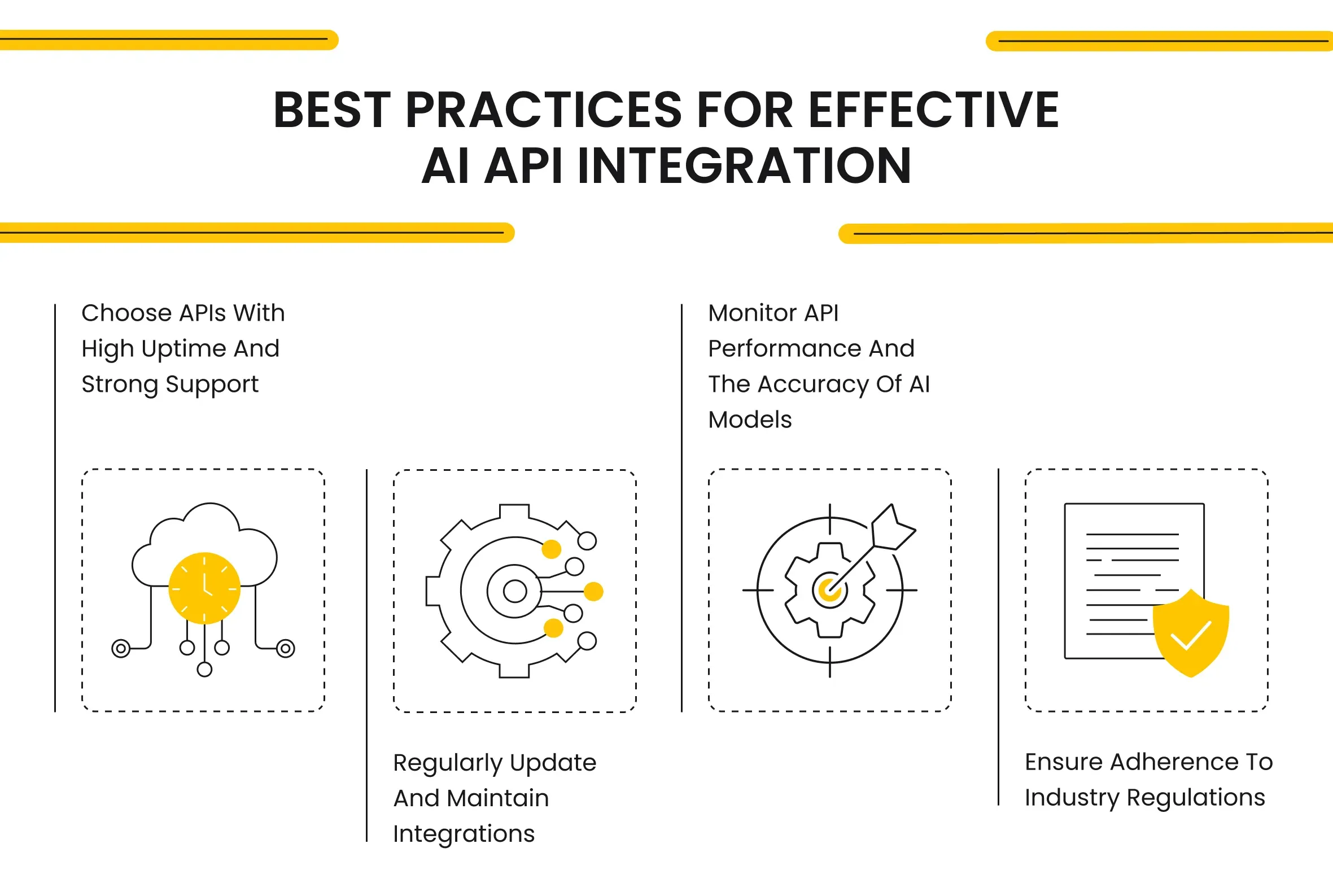AI API Integration for Seamless Business Automation
February 21, 2025 • 156 Views • 17 min read
Tetiana Stoyko
CTO & Co-Founder
The evolution of artificial intelligence still takes place. Most modern generative AI capabilities are scaling and increasing use cases for such software.
Such AI tools offer many features and benefits to businesses. Moreover, the open-source nature of popular models like ChatGPT from OpenAI makes it possible to seamlessly integrate ready-made AI to automate specific business operations and services.
However, you must learn their basics before integrating AI and machine learning into your business logic.
Understanding AI API Integration
Companies can use AI thanks to the Application Programming Interface or simply APIs. Such solutions make using the best AI models possible without creating artificial intelligence from scratch. Long story short, API is a “bridge” between your software and other third-party services, offering seamless access to their functionality.
As a result, modern businesses don't need to maintain a complex and resource-intensive process of designing, developing, and training new artificial intelligence solutions. Instead, you can use a range of AI solutions by simply deploying their APIs.
Nevertheless, even after enabling such functionality, you must customize integrated models by training them according to your needs and expectations. So, with just a little effort, companies can afford complex AI business process automation, saving costs and time on repetitive and manual tasks.
For a better illustration, let's consider some examples of using AI APIs for business needs.
Examples of AI APIs for Business Automation

To simplify it, new AI solutions can deal with numerous specific tasks. Yet, to enable such functionality, you have to integrate a pre-trained model, choosing the corresponding API from the list:
- Natural Language Processing (NLP) APIs
- Voice-to-Text APIs
- Image Recognition APIs
- Predictive Analytics APIs
- Chatbot and Virtual Assistant APIs
- Automation and Workflow APIs
Frankly, most such software can be operated only by text commands. However, many virtual assistants can analyze images and videos, as well as offer speech recognition functionality. Most of these intelligent features are based on text recognition under the hood.
Long story short, it still requires texting, regardless of how advanced machine learning is. So, to enable such functionality, companies slightly changed the AI algorithms process by creating functionality like speech-to-text, which is responsible for distinguishing human voice and transcribing it into text for further processing capabilities.
Natural Language Processing APIs
These powerful AI solutions are the most popular and widespread among modern services.
These are the most basic versions of AI platforms, operated via chatting. Such models can understand human language, even if it isn't perfect and includes mistakes.
Many tech giants and industry pioneers like OpenAI API or Google services offer NLP artificial intelligence. ChatGPT, Gemini, IBM Watson: all these are chatbots, i.e., they are operated in text format. Still, these AI business integrations can be scaled to perform more advanced features like data analysis, predictive analytics, process automation, speech-to-text transcription, etc.
Many such scaled APIs are distributed as new solutions like Google Speech-to-text or Whisper.
Voice-to-Text API
Thanks to voice recognition and transcription, companies can offer new user experiences, giving them more options for interaction with an app.
Besides being a fun feature to try out, voice-operated applications, businesses can make their applications more accessible and convenient for a large group of people in different circumstances.
Just a few years ago, voice assistants were primarily offered by tech giants like Amazon or Apple. Nowadays, any company can provide such services for a rational and fair price. For instance, one of our latest cases, VoiceOrder.ai, aimed to offer customers the possibility of ordering food using only their voice.
Image Recognition AI
Using computer vision is also an affordable yet powerful function that can be enabled using the API. Several open-source or paid options for AI-powered solutions can already be integrated into your product. For example, it can be Cloud Vision API, Imagga, CloudSight, or any alternative.
Such software is capable of defining objects in their view and categorizing them. It can also be trained for many other specific requirements like optical character recognition, finding related images, etc.
Nevertheless, such complex tasks require training and integrated systems personalization before showing the expected results.
Predictive Analytics
AI can also efficiently perform tasks related to data analysis. Long story short, such content based instruments can handle high volumes of inquiries and data inputs, with further summarization and analysis.
However, apart from simply summing up the given information, virtual assistants can distinguish patterns and predict further changes in the chosen field, whether it is market changes or a student's learning curve.
Also, this powerful instrument can help developers find bugs or ways to optimize or even take part in code generation, making it more efficient. Among such API today, we can name GitHub Copilot and different APIs alternatives.
Chatbots and Virtual Assistants
Once again, powerful machine learning models and similar solutions offer the most benefits in tasks related to text generation.
Such simple integrations help organizations to create a more convenient and structured environment for all parties engaged in business processes:
Companies can save their resources by automating different tasks. At the same time, users can access more advanced services like customer support, which is available 24/7 and answers any requests in less than a few seconds.
All your business has to do is to find a solution with an open-source API key for further implementation into the software system. Therefore, you can access advanced AI capabilities without the need to pay for their usage or maintain R&D on your own.
Automation and Workflow Integrations
Last but not least, you can use all the previously mentioned benefits and use cases to streamline multiple business operations under the hood.
Such new-age software solutions can perform multiple processes, depending on what assignments you will give them. AI can serve many repetitive tasks like answering frequently asked questions, gathering and analyzing big arrays of data, creating predictions, helping personalize user content, and so on.
Yet, don't forget that even if you don't need to build such models on your own, simply integrating APIs available for free is not enough. Apart from that, you still have to spend time and resources training these systems for better and more accurate responses.
What Should You Look for When Choosing an AI API?

So, what should you take into account when building the integration? Despite the wide variety of factors that count, we can narrow down the list to four main aspects:
- Type of AI Functionality
- Ease of Integration
- Scalability and Performance
- Cost and Pricing Model
Type of AI Functionality
The first and most obvious factor to consider is the type of AI you need. For example, a chatbot would be a better solution than an image recognition API if you are willing to automate customer support services.
Thus, your first step would be to define the core business goals and tasks you want to streamline, thanks to API access. Depending on these tasks and use purposes, you can make the right choice of tech solutions for your needs.
Each of these foregoing API models can bring much value to a whole range of applications if implemented and used correctly. Nevertheless, starting with the most suited and matching solutions to satisfy your primary goals is better.
Ease of Integration
The ease and simplicity of third-party software implementation is a very crucial factor when you build applications.
Apart from impacting the pace of the development process, this aspect can also play an essential role in the foregoing scaling and improvement. For instance, the ease of adopting new technology also defines the pace and efficiency of further training and correspondence with the set tasks.
Still, evaluating such factors is challenging because it demands software knowledge, as well as experience in the development of AI. So, the best way to estimate the ease and suitability of the chosen model - is to have a specialist on board. If you don't have such an expert on your team, you shouldn't hesitate to find a reliable tech partner familiar with such technologies.
Scalability and Performance
Another aspect worth mentioning is the possibilities for scalability and performance metrics.
Machine learning APIs are not a finished product. Like any other software, they tend to scale and upgrade. So, you should learn more about the scalability of the preferred model, its usage limits, and ways to deal with such limitations.
Apart from that, you must estimate the performance and related limitations of the chosen cloud AI. Once again, such testing requires technical skills. So, allow developers to help you and decide whether your preferred solution suits your needs.
Besides, such experts can suggest better software for your specific needs. For instance, they understand all the aspects and differences between Google speech-to-text and Whisper on a much deeper level, knowing each system's pros and cons.
Cost and Pricing
Finally, don't forget to pay attention to the final cost of such software implementation. Despite being open-source, API also requires some expenses.
In the case of implementing complex or custom solutions, you will have to spend a lot on experienced developers capable of delivering the expected results. Alternatively, even if you choose a ready-made solution, you will still have to spend resources on testing and training processes.
As was mentioned before, AI APIs helps to achieve better cost-efficiency in the long run. Nevertheless, they require some preparations to show proper results. In other words, you must train your models to ensure their performance and accuracy of final output.
Finally, you will likely have to spend money on further software maintenance and improvement to enhance user experience, maintain high-accuracy results, and correspond with the business industry.
How to Integrate AI APIs into Your Existing Software

Implementing API solutions into your software is similar to scaling other software functionality. So, the core steps include:
- Selecting the Appropriate AI API
- Verifing Compatibility with Your Existing Systems
- Integrating the API with Your Current Systems
- Testing and Optimizing the Integration
All steps are apparent and straightforward. Apart from finding an appropriate API, you should ensure it meets your expectations and business needs.
You need a corresponding solution for AI business process automation. For instance, you should prioritize chatbots or NLP models over image recognition software to streamline customer support services. Apart from that, you also have to verify the compatibility of such software with your system.
Once again, the best and only way to do so is to hire a niche-experienced developer familiar with such software. Such specialists will help you not only to choose the most suited solution but also integrate it and adjust it to your business needs and goals.
Best Practices for Effective AI API Integration

Summing up all the above, let's discuss the best ways to make the right and informed choice. Frankly, multiple factors can make you change your final decision. Yet, the most productive approach to choosing, implementing, and sustaining API solutions includes just four essential steps:
- Choose APIs with high uptime and strong support
- Regularly update and maintain integrations
- Monitor API performance and the accuracy of AI models
- Ensure adherence to industry regulations
We have already covered the first three stages. The last one is worth a few extra words.
Unfortunately, despite all the benefits of AI API integrations, they still have a lot of limitations. For instance, such software is distributed by third parties and is content-driven. The modern IT industry is highly regulated and must correspond with many regional and international laws.
So, apart from implementing and tracking the performance of API, you also have to ensure it meets the industry regulations and specifics. Besides, don't forget about data privacy and security measures: even SaaS vendors like OpenAI notify users about their privacy and the threats of discussing personal or confidential information with ChatGPT.
The reason for such concerns is that such models are trained on the data they get. So, when you feed them with private information, it might be used later in chats with other users by ChatGPT.
What’s your impression after reading this?
Love it!
1
Valuable
2
Exciting
1
Unsatisfied
1
FAQ
Let us address your doubts and clarify key points from the article for better understanding.
How do you integrate AI API?
To integrate an AI API, follow these steps:
- Choose an AI API – Select an API that fits your needs (e.g., OpenAI, Google AI, AWS AI).
- Get API Key – Sign up and obtain authentication credentials.
- Set Up Environment – Install required libraries (e.g.,
requests,openai). - Make API Calls – Send HTTP requests (usually JSON) to the API endpoint.
- Handle Responses – Process the API’s output in your application.
- Optimize & Secure – Implement rate limiting and secure API keys.
What challenges might businesses face during AI API integration?
Businesses may face challenges like:
- Compatibility Issues – Ensuring the AI API works with existing systems.
- Data Security & Privacy – Protecting sensitive data and complying with regulations.
- Cost Management – Controlling API usage costs and scaling efficiently.
- Latency & Performance – Ensuring real-time responses and reliability.
- Customization Limits – Adapting AI models to specific business needs.
How can AI API integration benefit my business?
AI API integration can benefit your business by:
- Automating Tasks – Reducing manual work and increasing efficiency.
- Enhancing Customer Experience – Powering chatbots, recommendations, and support.
- Improving Decision-Making – Providing data-driven insights and analytics.
- Boosting Productivity – Streamlining workflows and optimizing operations.
- Scaling Easily – Adapting AI capabilities as your business grows.
How long does it take to integrate AI APIs into an existing system?
The time to integrate AI APIs varies based on complexity:
- Basic Integration – A few hours to a couple of days (e.g., chatbot, simple automation).
- Moderate Integration – A few weeks (e.g., AI-powered analytics, recommendation systems).
- Complex Integration – Several months (e.g., custom AI models, enterprise-level solutions).
Factors like API complexity, system compatibility, and data preparation impact the timeline.
you may also like
Let’s talk!
This site uses cookies to improve your user experience. Read our Privacy Policy
Accept

Share this article